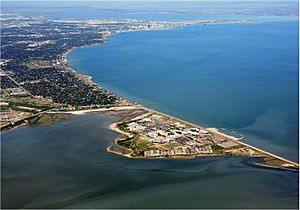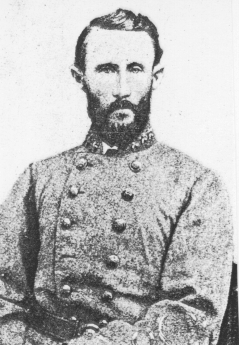Battle of Corpus Christi facts for kids
Quick facts for kids Battle of Corpus Christi |
|||||||
|---|---|---|---|---|---|---|---|
| Part of the Trans-Mississippi Theater of the American Civil War |
|||||||
 Corpus Christi in 1887 |
|||||||
|
|||||||
| Belligerents | |||||||
| Commanders and leaders | |||||||
| Strength | |||||||
| Land: 100 sailors 1 artillery piece Sea: 1 bark 1 sloop-of-war 1 schooner 1 steamer 1 yacht |
Land: 700 militia 5 artillery pieces 1 fort Sea: 1 sloop-of-war 2 schooners 1 steamer |
||||||
| Casualties and losses | |||||||
| ~2 wounded 1 sloop-of-war damaged 1 steamer damaged 1 yacht damaged |
1 killed 1 wounded 1 schooner captured 1 schooner scuttled 1 sloop-of-war scuttled 1 steamer scuttled 1 fort damaged |
||||||
The Battle of Corpus Christi was a fight during the American Civil War. It happened between August 12 and August 18, 1862. The United States Navy (also called the Union Navy) tried to stop supplies from reaching the Confederate States in Texas. This battle involved both ships and soldiers fighting on land.
Union ships attacked Confederate forces in and around Corpus Christi Bay. They also fired cannons at the town of Corpus Christi. The Union Navy won against Confederate ships in the area. However, Union soldiers were stopped when they tried to land on the coast.
Contents
Why the Battle Happened
Texas was a very important place for the Confederate forces. It provided many supplies during the American Civil War. Because of this, the Union Navy started to blockade the Texas coast. A blockade means they used ships to stop other ships from entering or leaving ports.
Corpus Christi was a town in Texas. It had people who supported both the Confederacy and the Union.
Ships Involved in the Battle
Nine ships were part of this battle. Five belonged to the Union Navy and four to the Confederate Navy.
- The Union Navy ships were:
- The Confederate Navy ships were:
- A sloop named CSS Breaker
- A schooner named CSS Elma
- Another sloop named CSS Hannah
- A merchant steamer called A.B. or A. Bee
Lieutenant John W. Kittredge led the Union ships. His ship, the Arthur, was the main ship, called the flagship. It had over eighty men and six cannons. The Sachem was commanded by Lieutenant Amos Johnson. It had a crew of about fifty and several cannons.
Confederate Forces on Land
The Confederate soldiers in Corpus Christi were mostly militia. Militia are regular citizens who train to be soldiers. They had a few cannons. Later, more militia arrived, bringing more cannons. In total, about 700 Confederate soldiers were involved.
The main Confederate base was a fort called Fort Kinney. It was inside the town's citadel. Major Alfred M. Hobby was in charge of these soldiers.
The Battle Begins
The battle started on August 12. Union ships were sailing into Corpus Christi Bay. They saw a Confederate ship, the CSS Breaker. This ship had Confederate sailors and soldiers on board.
The Union ships chased the Breaker. To stop the Union from capturing it, the Confederate commander ran his ship aground. Then, he set it on fire. Union sailors tried to put out the fire and capture the ship. But the Confederate crew escaped by land. The Union sailors put out the fire and took the Breaker.
After this, other Confederate ships in the bay, the CSS Elma and CSS Hannah, were also sunk by their own crews. This was done to prevent the Union from capturing them.
The Blockade and Waiting Game
After capturing the Breaker, the Union ships sailed to Corpus Christi. They set up a blockade around the town. This meant no ships could get in or out.
Lieutenant Kittredge, the Union commander, sent his main ship, the Arthur, away for supplies. He moved his flag to the Corypheus. The captured Breaker was used as a hospital ship for wounded soldiers.
On August 13, Lieutenant Kittredge went ashore. He demanded that the Confederates surrender the town. He also offered a 48-hour break in fighting. This break would allow women and children to leave the town safely. The Confederates refused to surrender.
The Union ships continued the blockade for the next two days. Kittredge did not attack when the truce ended on August 16. The Confederates used this extra time to make their fort even stronger.
Fighting at Fort Kinney
On August 17, the Confederates attacked the Union ships at dawn. Lieutenant Kittredge's ships fired back with their cannons. They would silence the fort's guns for a while. But as soon as the Union ships stopped firing, the Confederates would start shooting again. This went on all day and night.
The Union ships Sachem and Corypheus were slightly damaged. A Union sailor on the Belle Italia was also wounded. Kittredge pulled his ships back when it got dark.

Later that night, the Belle Italia sent a small group of thirty sailors ashore. They brought a cannon with them. Their goal was to attack the fort. At the same time, Confederate forces sank their ship A.B. in a shallow channel. Kittredge tried to tow the A.B. out of the channel. He wanted to either capture it or stop it from blocking the way.
The Union ships stayed far from the fort. This helped prevent many injuries on both sides. But it also made their cannon fire less accurate. The Confederate gunners were not well trained. They also did not have enough gunpowder to practice before the battle.
The next morning, the Union landing party moved closer to the fort. Fighting started again, and the Union ships began firing their cannons once more. Major Hobby and twenty-five Confederate soldiers moved forward to defend their cannons. Other Confederate soldiers on horseback also joined the fight.
The Union sailors fought hard. Their ships helped them by firing cannons at the fort. But after a long fight, the Union soldiers on land started to run out of ammunition. They began to retreat back to the Belle Italia. The Union ships helped cover their retreat.
The Union forces did not capture Fort Kinney. But their cannon fire did silence it. The Confederates then moved back into the town. Union sailors saw this movement. Kittredge ordered his ships to fire at the buildings where the Confederates had gone. Many houses and stores were damaged.
After the Union ships ran out of ammunition, the battle ended. Kittredge ordered his ships to sail north to Aransas Bay.
During the attack, a Union supporter in Corpus Christi named John Dix tried to wave an American flag. He wanted to show the Union ships that he supported them. But his daughter-in-law stopped him. Her husband was fighting for the Confederacy. She pointed a shotgun at Dix until he put the flag away. After the shelling, some angry Confederates looted houses belonging to Union supporters.
What Happened After the Battle
The exact number of people hurt or killed is not fully known. Two Union sailors were wounded. At least one Confederate soldier was killed, and Major Hobby was slightly wounded.
After the battle, the Union ships met up with the Arthur in Aransas Bay. The Union Navy won the battle in terms of controlling the sea. They stopped Confederate ships and silenced the fort. However, the Confederate forces still held the town and the fort after the battle. This means the Union won the immediate fight (a tactical victory), but the Confederates kept control of the area (a strategic victory).
Ships in the Battle
- USS Arthur, a large sailing ship (the main ship)
- USS Belle Italia, a small sailing ship
- USS Sachem, a steam-powered ship
- USS Corypheus, a small, fast ship (became the main ship later)
- USS Reindeer, a sailing ship with two masts
- CSS Hannah, a small sailing ship
- CSS Breaker, a sailing ship with two masts
- CSS Elma, a sailing ship with two masts
- A.B., a steam-powered merchant ship


